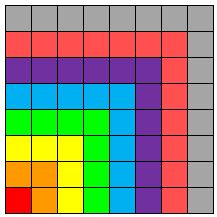This one comes from the Grade 6 book (I assume this is the
equivalent to Year 7 in England).
Week 4 has this:
Good things: The pupils will be practising following an
algorithm. There is some mental maths
involved.
Bad things: The idea of having an algorithm (that you are
expected to remember) to subtract a three-digit number from its reverse is a
bit extraordinary! There are potential
problems with the way it is set out. The
opportunity to explore this, to explain why, to use some algebra, to create a
better formula and to expand it to other numbers of digits has been missed.
The potential problem: “Find the difference of the hundreds digits”. This would mean that 598 – 895 has the same
answer as 895 – 598.
In the classroom: We could try a few of these out to convince
ourselves that this always works. The
pupils might wonder why the middle number isn’t mentioned in the
algorithm. Hold on: if we reverse a
3-digit number then the middle number is in the middle both times, so when you
subtract them this gives zero.
Let’s try some algebra.
It might be natural for pupils to want to show this as ABC – CBA (particularly
if they have previously worked on letter-substitution puzzles). It would be good to explore why this doesn’t work
with algebra. (ABC means AxBxC.)
If we use their example of 895 and want to have a = 8, b=9
and c=5 then we actually need 100a + 10b + c.
The reverse of this will be 100c + 10b + a. When you subtract you get 100a + 10b + c –
100c – 10b – a, which simplifies to give 99a – 99c. Factorising this gives 99(a – c).
This explains why we subtract the hundreds digits, and then why
we multiply by 100 and subtract that difference again (leaving 99 of them).
Extensions:
We could try 2-digit reverses:
10a + b – 10b – a = 9(a – b), which means that for 2-digit
reverses you subtract the digits and then multiply by 9 (which also means that
the answer is always a multiple of 9).
We could then do a similar thing for 4-digit reverses…








